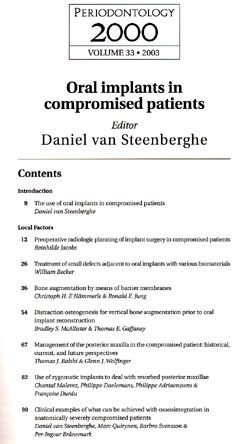Management of the Posterior Maxilla in the Compromised Patient: Historical, Current, and Future Perspectives
CONTINUED (Page 9)
Thomas J. Balshi & Glenn J. Wolfinger
Periodontology 2000, Vol 33, 2003, 67-81.
JOURNAL TABLE OF CONTENTS (At Left)
Conclusion
Although management of the posterior maxilla presents many challenges for the implant practitioner, progress on a number of fronts has made it increasingly possible to create successful bone-anchored restorations in this region predictably. When at least 8mm of bone exists below the sinus, standard implant therapy can be considered, particularly in immediate extraction sites or when wider-diameter implants can be employed. A variety of grafting procedures, including sinus lift grafts, may be considered when bone loss is more extensive. Alternatively, the use of implants that obtain support from more distant bony sites such as the pterygomaxillary region or the zygomatic bone has also proven successful. Future breakthroughs in the areas of tissue and genetic engineering are likely to enhance these developments still further. In the meantime, although a few compromising conditions contraindicate the placement of implants in the posterior maxilla, the use of such implants in patients who are diabetic, smokers, osteoporotic, or who have Crohn’s disease or severe parafunctional habits can be a prudent option, given proper management of each condition.
